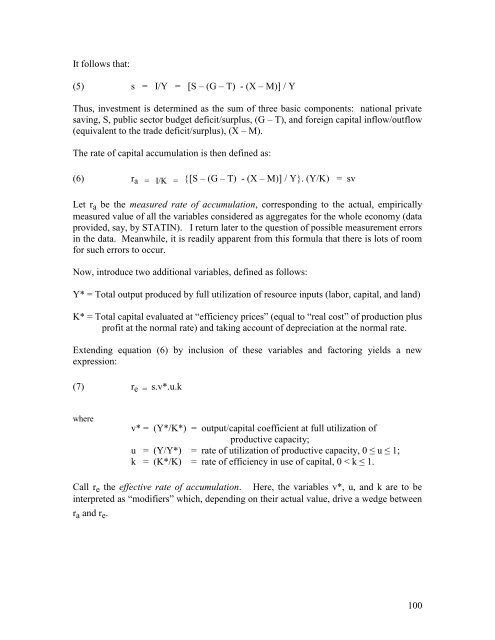PIOJ Growth-Inducement Strategy - Planning Institute of Jamaica
PIOJ Growth-Inducement Strategy - Planning Institute of Jamaica
PIOJ Growth-Inducement Strategy - Planning Institute of Jamaica
You also want an ePaper? Increase the reach of your titles
YUMPU automatically turns print PDFs into web optimized ePapers that Google loves.
It follows that:<br />
(5) s = I/Y = [S – (G – T) - (X – M)] / Y<br />
Thus, investment is determined as the sum <strong>of</strong> three basic components: national private<br />
saving, S, public sector budget deficit/surplus, (G – T), and foreign capital inflow/outflow<br />
(equivalent to the trade deficit/surplus), (X – M).<br />
The rate <strong>of</strong> capital accumulation is then defined as:<br />
(6) r a = I/K = {[S – (G – T) - (X – M)] / Y}. (Y/K) = sv<br />
Let r a be the measured rate <strong>of</strong> accumulation, corresponding to the actual, empirically<br />
measured value <strong>of</strong> all the variables considered as aggregates for the whole economy (data<br />
provided, say, by STATIN). I return later to the question <strong>of</strong> possible measurement errors<br />
in the data. Meanwhile, it is readily apparent from this formula that there is lots <strong>of</strong> room<br />
for such errors to occur.<br />
Now, introduce two additional variables, defined as follows:<br />
Y* = Total output produced by full utilization <strong>of</strong> resource inputs (labor, capital, and land)<br />
K* = Total capital evaluated at “efficiency prices” (equal to “real cost” <strong>of</strong> production plus<br />
pr<strong>of</strong>it at the normal rate) and taking account <strong>of</strong> depreciation at the normal rate.<br />
Extending equation (6) by inclusion <strong>of</strong> these variables and factoring yields a new<br />
expression:<br />
(7) r e = s.v*.u.k<br />
where<br />
v* = (Y*/K*) = output/capital coefficient at full utilization <strong>of</strong><br />
productive capacity;<br />
u = (Y/Y*) = rate <strong>of</strong> utilization <strong>of</strong> productive capacity, 0 ≤ u ≤ 1;<br />
k = (K*/K) = rate <strong>of</strong> efficiency in use <strong>of</strong> capital, 0 < k ≤ 1.<br />
Call r e the effective rate <strong>of</strong> accumulation. Here, the variables v*, u, and k are to be<br />
interpreted as “modifiers” which, depending on their actual value, drive a wedge between<br />
r a and r e .<br />
100
















